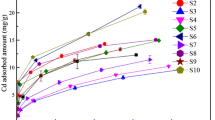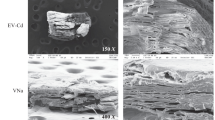Abstract
The use of vermicompost was expanded as natural adsorbent for cationic dyes retention. The adsorption profiles in batch and flow modes for crystal violet and methylene blue on vermicompost material were evaluated. In batch mode, a retention index higher than 97% was obtained for both compounds, while in flow condition, 40 g of dried adsorbent material were enough to remove 100 mg of crystal violet or methylene blue at column flow rates of 5 and 20 mL min−1. Adsorption isotherms showed adsorptive maximum capacities for vermicompost of 0.78 and 5.47 mg g−1, respectively, which were compatible with the literature. Due to this good efficiency capacity, incineration steps can be considered as acceptable disposal procedures for enriched vermicompost. From these characteristics, economical and environmental advantages of the proposed material for the evaluated cationic dyes retention were evidenced.






Similar content being viewed by others
References
Akbal, F. (2005). Adsorption of basic dyes from aqueous solution onto pumice powder. Journal of Colloid and Interface Science, 286(2), 455–458. doi:10.1016/j.jcis.2005.01.036.
Arogus, A. Z., Gulen, J., & Evers, R. H. (2008). Adsorption of methylene blue from aqueous solution on pyrolyzed petrified sediment. Bioresource Technology, 99(6), 1503–1508. doi:10.1016/j.biortech.2007.04.033.
Bailey, S. E., Olin, T. J., Bricka, R. M., & Adrian, D. D. (1999). A review of potentially low-cost sorbents for heavy metals. Water Research, 33(11), 2469–2479. doi:10.1016/S0043-1354(98)00475-8.
Chatzisymeon, E., Xekoukoulotakis, N. P., Coz, A., Kalogerakis, N., & Mantzavinos, D. (2006). Electrochemical treatment of textile dyes and dyehouse effluents. Journal of Hazardous Materials, A137(2), 998–1007. doi:10.1016/j.jhazmat.2006.03.032.
Dart, R. K. (1996). Microbiology for analytical chemist. London: The Royal Society of Chemistry.
Fernández-Bayo, J. D., Romero, E., Schnitzler, F., & Burauel, P. (2008). Assessment of pesticide availability in soil fractions after the incorporation of winery-distillery vermicomposts. Environmental Pollution, 154(2), 330–337. doi:10.1016/j.envpol.2007.10.002.
Holt, M. S. (2000). Sources of chemical contaminants and routes into the freshwater environment. Food and Chemical Toxicology, 38(Supplement 1), S21–S27. doi:10.1016/S0278-6915(99)00136-2.
Jordão, C. P., Fialho, L. L., Neves, J. C. L., Cecon, P. R., Mendonça, E. S., & Fontes, R. L. F. (2007). Reduction of heavy metals contents in liquid effluents by vermicompost and the use of the metal-enriched vermicomposts in lettuce cultivation. Bioresource Technology, 98(15), 2800–2813. doi:10.1016/j.biortech.2006.06.023.
Jordão, C. P., Pereira, M. G., Einloft, R., Santana, M. B., Bellato, C. R., & de Mello, J. W. V. (2002). Removal of Cu, Cr, Ni, Zn and Cd from electroplating wastes and synthetic solutions by vermicompost of cattle manure. Journal of Environmental Science and Health. Part A, Environmental Science and Engineering & Toxic and Hazardous Substance Control, 37(5), 875–892.
Lambert, J. B., Shurvell, H. F., Lightner, D. A., & Cooks, R. G. (1998). Organic structural spectroscopy. New Jersey: Prentice-Hall.
Landgraf, M. D., da Silva, S. C., & Rezende, M. O. O. (1998). Mechanism of metribuzin herbicide sorption by humic acid samples from peat and vermicompost. Analytica Chimica Acta, 368(1–2), 155–164. doi:10.1016/S0003-2670(98)00049-X.
Lee, C., Low, K., & Chow, S. (1996). Chrome sludge as an adsorbent for color removal. Bioresource Technology, 54(2), 183–189. doi:10.1016/0960-8524(95)00130-1.
Li, L., Wang, S., & Zhu, Z. (2006). Geopolymeric adsorbents from fly ash for dye removal from aqueous solutions. Journal of Colloid and Interface Science, 300(1), 52–59. doi:10.1016/j.jcis.2006.03.062.
Lindsay, W. L. (1979). Chemical equilibria in soils. New York: Wiley.
Manahan, S. E. (1994). Environmental chemistry. Boca Raton: Lewis.
Mason, T. J. (1990). The uses of ultrasound in chemistry. London: The Royal Society of Chemistry.
Matos, G. D., & Arruda, M. A. Z. (2003). Vermicompost as an adsorbent for removing metal ions from laboratory effluents. Process Biochemistry, 39(1), 81–88. doi:10.1016/S0032-9592(02)00315-1.
Otero, M., Rozada, F., Calvo, L. F., Garcia, A. I., & Morán, A. (2003). Elimination of organic water pollutants using adsorbents obtained from sewage sludge. Dyes and Pigments, 57(1), 55–65. doi:10.1016/S0143-7208(03)00005-6.
Pace, L. A., Miller, R. H., & Keeney, D. R. (1982). Methods of soil analysis, part 2—chemical and microbiological properties (2nd ed.). Madison: Soil Science Society of America.
Pavan, F. A., Mazzocato, A. C., & Gushikem, Y. (2008). Removal of methylene blue dye form aqueous solutions by adsorption using yellow passion fruit peel as adsorbent. Bioresource Technology, 99(8), 3162–3165. doi:10.1016/j.biortech.2007.05.067.
Pearce, C. I., Lloyd, J. R., & Guthrie, J. T. (2003). The removal of colour form textile wastewater during whole bacterial cells: a review. Dyes and Pigments, 58(3), 179–196. doi:10.1016/S0143-7208(03)00064-0.
Pereira, M. G., & Arruda, M. A. Z. (2003). Vermicompost as a natural adsorbent material: characterization and potentialities for cadmium adsorption. Journal of the Brazilian Chemical Society, 14(1), 39–47. doi:10.1590/S0103-50532003000100007.
Pereira, M. G., & Arruda, M. A. Z. (2004). Preconcentration of Cd(II) and Pb(II) using humic substances and flow systems coupled to flame atomic absorption spectrometry. Mikrochimica Acta, 146(3–4), 215–222. doi:10.1007/s00604-004-0231-5.
Rocha, J. C., Rosa, A. H., & Furlan, M. (1998). An alternative methodology for the extraction of humic substances from organic soils. Journal of the Brazilian Chemical Society, 9(1), 51–56.
Sag, Y., & Kutsal, T. (2000). Determination of the biosorption heats of heavy metal ions on Zoogloea ramigera and Rhizopus arrhizus. Biochemical Engineering Journal, 6(2), 145–151. doi:10.1016/S1369-703X(00)00083-8.
Solomons, T. W. G., & Fryhle, C. B. (1998). Organic chemistry. New York: Wiley.
Stevenson, F. J. (1982). Humus chemistry. New York: Wiley.
Tuomela, M., Vikman, M., Hatakka, A., & Itavaara, M. (2000). Biodegradation of lignin in a compost environment: a review. Bioresource Technology, 72(2), 169–183. doi:10.1016/S0960-8524(99)00104-2.
Wang, S., Li, H., & Xu, L. (2006). Application of zeolite MCM-22 for basic dye removal from wastewater. Journal of Colloid and Interface Science, 295(1), 71–78. doi:10.1016/j.jcis.2005.08.006.
Weber, W. J., Jr., & LeBoeuf, E. J. (1999). Processes for advanced treatment of water. Water Science and Technology, 40(4–5), 11–19. doi:10.1016/S0273-1223(99)00480-1.
Acknowledgements
The authors thank the Fundação de Amparo à Pesquisa do Estado da Bahia (FAPESB, Salvador, BA, Brazil), Conselho Nacional de Desenvolvimento Científico e Tecnológico (CNPq, Brasília, DF, Brazil), and Ministério da Educação e Cultura (PET/SESu/MEC, Brasília, DF, Brazil) for the research fellowships and financial supports. The authors are also grateful to Dr. André Galembeck, Ph.D. (Instituto de Química, Universidade Federal de Pernambuco, Recife, PE, Brazil) for the X-ray analysis.
Author information
Authors and Affiliations
Corresponding author
Rights and permissions
About this article
Cite this article
de Godoi Pereira, M., Korn, M., Santos, B.B. et al. Vermicompost for Tinted Organic Cationic Dyes Retention. Water Air Soil Pollut 200, 227–235 (2009). https://doi.org/10.1007/s11270-008-9906-6
Received:
Accepted:
Published:
Issue Date:
DOI: https://doi.org/10.1007/s11270-008-9906-6




